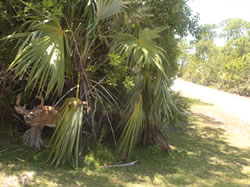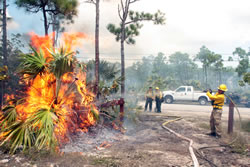Forests and Rangelands Success Story
Refuge Burns to Preserve Rare Ecosystem
U.S. Fish and Wildlife Service, National Key Deer Refuge, Florida
Healthy Forests - Fuels Reduction
2010

A Key Deer peeks out of heavy underbrush on Big Pine Key. Firefighters lit prescribed fire this summer to reduce the overgrown brush to enhance Key Deer habitat at the National Key Deer Refuge in Florida. Credit: U. S. Fish and Wildlife Service.

A USFWS firefighter helps cool the flames from a prescribed burn performed on the National Key Deer Refuge in Florida. Credit: U. S. Fish and Wildlife Service.
Home to one of the rarest ecosystems in the world, the National Key Deer Refuge recently completed their first prescribed burning in five years. Although an essential tool to maintain the biological diversity of the fire-dependent and endangered pine rocklands unique to the Florida Keys, the Everglades and the Bahamas, use of fire had been complicated following the devastation and unnatural amounts of debris left scattered in the area by Hurricane Wilma in 2005. The hurricane debris and lack of fire in the area had also left nearly 4,600 nearby residents vulnerable to high intensity wildfire.
Fire managers and biologists from the refuge staff began a multi-year interagency and community based effort in 2006 to reduce fire risk on the island and to reintroduce fire as an ecologically appropriate tool to conserve the pine rockland habitat. Characterized by slash pine trees, tropical palms, hardwood trees and a wide diversity of herbaceous rare plants, pine rocklands provide critical habitat for the tiny endangered Key Deer.
Two successful prescribed fires were conducted late during summer 2009 as part of this planning effort. By burning, firefighters effectively reduced the risk of wildfire to private property, enhanced Key Deer habitat by maintaining openings and promoting new plant growth, and preserved conditions under which pines can regenerate and the rare herbaceous flora unique to this landscape will thrive.
Encouraging public involvement has allowed the Service and other partners to foster new relationships creating opportunities to share current information and explore new strategies for the fire management program. This will be instrumental in future prescribed burning and other hazardous fuels activities on the refuge.